As the Economy Wanes Tokyo Homelessness Grows
The class turned to page 89 of their textbooks. "Now, this dialogue is a sample negotiation," I said.
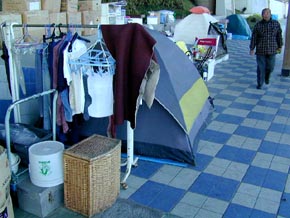 My pack of smokes sat at the edge of the lectern. "Let's quickly review." I wiggled one loose. "Hiroshi, what is the first rule when negotiating with the tout?"
My pack of smokes sat at the edge of the lectern. "Let's quickly review." I wiggled one loose. "Hiroshi, what is the first rule when negotiating with the tout?"
He squirmed in his eleventh row seat, not expecting to be singled out amongst the university's full lecture hall." Don't be aggressive...even if it's a 'sexy massage,'" he offered.
"Right you are." I tapped the lectern with my pointer and exhaled one long puff. "And then, what do you do after she shows you the menu and explains the extras?"
He paused, obviously replaying the details of the lab session from a week earlier in his mind. One day this will be reflex. But at this stage of learning, rote memory is acceptable. He then cautiously mustered, "Slowly...shake my head from side to side to feign disgust?"
Just then, the back door swung open. I leaned on the front edge of the lectern and peered at the silhouette filling the doorway.
"What the hell is going on?" boomed a familiar voice. It was junior reporter Junko.
I smiled and quickly shot back: "Massage Parlor 101: Lecture 5 - Negotiating with the Tout...I'm afraid enrollment ended three weeks ago, my dear. But auditing this class is acceptable."
She slowly made her way down the aisle, screaming as she approached the front. "The Boss wanted your homeless piece yesterday!"
I shook my head at the lack of respect shown these days within the hallowed halls of academia, snuffed out my cigarette, and reached for my satchel.
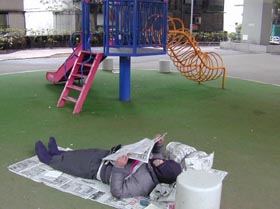 Toshiba, Sony, Sanyo, and Panasonic. They're all symbols of Japan's industrial might. And they're all here, lined up, and representing a wide variety of consumer products: televisions, VCRs, computer monitors, radios, and heaters.
Toshiba, Sony, Sanyo, and Panasonic. They're all symbols of Japan's industrial might. And they're all here, lined up, and representing a wide variety of consumer products: televisions, VCRs, computer monitors, radios, and heaters.
What might at first sound like a department store showroom is instead a haul of discarded appliances that Minoru, 45, has accumulated in recent weeks.
Minoru (not wishing to give his family name) is homeless. Collecting and selling these items is one of his jobs - maybe more accurately, one of his means of survival. He is one of hundreds of similar folk who have been relegated to setting up abodes on the concrete terrace of the Sumida River beneath a massive expressway in Eastern Tokyo's Chuo Ward.
Here, and for intermittent stretches along the river, homeless villages have sprung up. Nearly permanent structures composed of a mixture of tents, wood pallets, cardboard, and blue tarps sit at the river's edge.
Even though international news reports often speak of Japan's stagnating economy as a "golden recession" by detailing Tokyo's still extremely high standard of living and endless consumer excess, the existence of homeless people is slowly encroaching inward from the outskirts of the capital. Where once easy to ignore, the blue tarps - the signature item of Japan's homeless - are now turning up in nearly all of Tokyo's larger parks and along its riverbanks.
"At first, I didn't know how to get by," Minoru says of his homeless beginnings one year before. "I was eating grass and bugs."
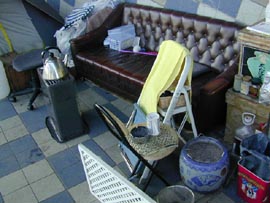 Now he has adapted.
Now he has adapted.
He prepares coffee, warming his hands on the kerosene heater, with fellow homeless buddy, 55-year old Sadami, sitting next to him on their brown vinyl couch. Two dome camping tents, one being camouflage, provide bookends at either side of their assortment of collected goods: pots, gas burners, generators, folding chairs, ceramic dishes, clothing racks, fishing poles, bicycles, pushcarts, and even seemingly insignificant items like ashtrays.
"Japanese people always throw away perfectly good stuff," laughs Minoru, who rummages through the trash of apartments and businesses in the nearby Hakozaki and Nihonbashi neighborhoods during the day to collect the discarded wares. Some days he makes his way over to the posh shopping district of Ginza to retrieve food from dumped restaurant garbage.
Though he is missing a few front teeth and coughs frequently, Minoru generally looks very well-kept in his outfit of leather cowboy boots, brown bomber jacket, and green knit hat.
For these men, their main means of employ is getting daily hire work as movers. Similar to the lives of Tokyo's laboring community described in San'ya Blues by Edward Fowler, Minoru and Sadami go to a yoseba (gathering place for part-time workers) where they can be hired by a contractor to do heavy lifting work.
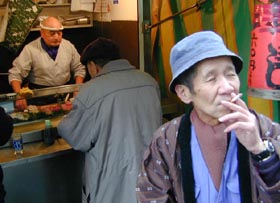 These days, though, Minoru estimates that the odds of getting such work on any particular day to be 1 in 10. "Still, it is usually enough to eat," Sadami says.
These days, though, Minoru estimates that the odds of getting such work on any particular day to be 1 in 10. "Still, it is usually enough to eat," Sadami says.
With Japan's stock market reaching lows not seen in two decades and unemployment rolls steadily filling, the number of homeless continues to swell. Recent estimates by the Ministry of Health, Labor, and Welfare have put the homeless total in Japan at nearly 25,000, an increase of more than 15% over the year before.
However, skeptics doubt the accuracy of the figures, believing the total to be much higher. This is based on the mercurial nature of the people and the denial of the severity of the situation by the government as evidenced by the oft-reported clearing of parks of its homeless occupants before any particular count takes place.
The dire situation is further being bolstered by the fact that Japan's construction industry - the prime source of work for day laborers like Minoru and Sadami - remains perhaps Japan's most hopeless industry.
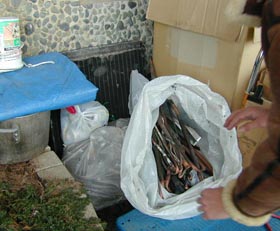 For the majority of Japan's white-collar work force, the effects of Japan's decade-long downturn have been cuts in salary. For these men, however, it now means no work at all. "The pay doesn't change," acknowledges Minoru. "But there are just fewer and fewer jobs."
For the majority of Japan's white-collar work force, the effects of Japan's decade-long downturn have been cuts in salary. For these men, however, it now means no work at all. "The pay doesn't change," acknowledges Minoru. "But there are just fewer and fewer jobs."
Shelters, too, are few in number with Japan's supply lagging way behind the West. Though this past summer government legislation was passed that will increase the ability for homeless to find work and shelters, Minoru says it won't help. "People don't want the facilities anywhere near their backyards," he says.
But society's lack of interest is something that doesn't concern them. After returning from urinating in the bushes, Minoru explains the situation as being very natural, as simple as something like survival of the fittest, "If you are old, weak, or injured, and cannot find work, you wind up here. That's it."
Wearing purple corduroy pants, a blue knit hat, a white towel around his neck, and geta (wood sandals), Sadami explains that in addition to selling their collected appliances up the river to a dealer, collecting cardboard, aluminum cans, and anything else that can be recycled is one way to get money when there is no moving work. Beer cans, he says, are the easiest to come by. Yet, Minoru emphasizes that "copper piping gets the highest price."
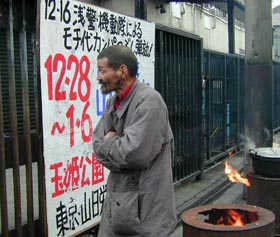 The violence shown by the numerous incidents of homeless being bludgeoned and burned by youths which has filtered trough the media over the past year has not reached this area of Tokyo. The main crimes mainly have included the theft of another's stash by a fellow homeless in need of money for food.
The violence shown by the numerous incidents of homeless being bludgeoned and burned by youths which has filtered trough the media over the past year has not reached this area of Tokyo. The main crimes mainly have included the theft of another's stash by a fellow homeless in need of money for food.
The police, too, keep their distance. Since the terrace is technically not a part of Chuo Ward, and is instead within the jurisdiction of the Tokyo Municipal Government, the local ward police don't bother with the squatters. "They only worry about the taxpayers," laughs Sadami, sipping his coffee.
With the full brunt of winter quickly approaching, the two will get a room at a cheap hotel on the colder nights if they have the money. But perspective is the key, implores Minoru, and such things are luxuries. "We are lucky if we get work and food."
Note: Ed Gelband contributed to this report from the Tokyo Bureau.

